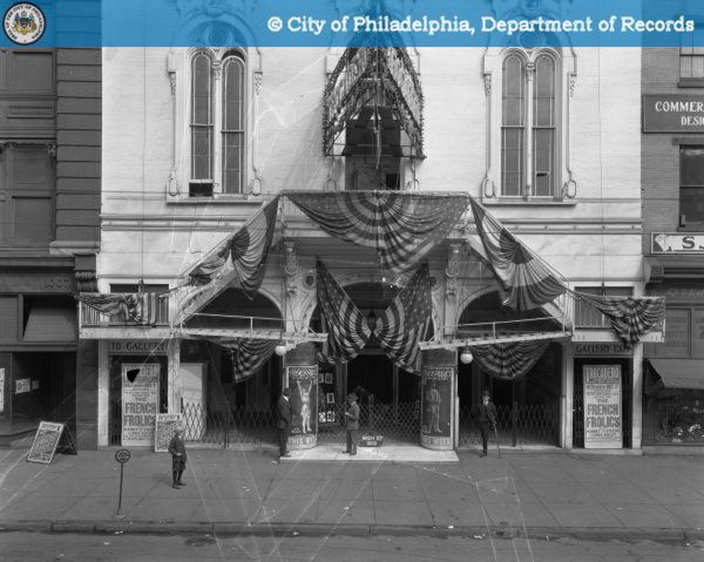researched and written by Tanijah Johnson and Ryan Norton
The Trocadero Theater’s 149-year history is marked by reinvention, as the venue in Philadelphia’s Chinatown changed in response to cultural shifts as well as economic necessity. Its original run as a theater space for minstrel shows and musical comedies, the popular entertainment at the time in the late 19th century, was followed by a turn to the burlesque at the start of the new century. For the next 75 years, the “Troc” specialized in strip-tease performances that drove the theater’s seedy reputation. It featured popular comedians of the day such as Red Skelton and Abbott and Costello along with “burlesque queens” Tempest Storm, Georgia Southern, Blaze Starr and Carlotta Tendant. By the late 70s, however, burlesque was significantly less popular, as many would-be patrons went to porn theaters for more explicit entertainment.
With its closing in 1978, the Troc was purchased by Stephen Pang, who converted it into a movie theater for Chinese cinema in addition to some live performances. The theater was a community staple for Chinatown residents, but after only 7 years, it started to focus on rock music performances. Movie screenings were less of a main attraction. The Troc drew many notable acts, including Pearl Jam, the Foo Fighters, and Bob Dylan. In the 21st century, its popularity as a rock music club waned as more and more venues opened up around Philly, until it finally closed in 2019. It remains to be seen whether a revival of the historic theater will occur.
The fate of old theater spaces is precarious, as debate remains over whether they should be preserved in their original state for historical importance, or updated and adapted to the times. The Troc seemingly struck a balance over the years in preserving its classic features and aesthetic while adapting the use of the space and the entertainment it provided. Still, it faced a bleak fate and now rests empty and silent after so many years of people coming through and stories being told. Even though it eventually closed, the Troc is not a failure in that its history is so rich and meaningful to the people involved.
Historical Timeline





1870 — opens as the “Arch Street Opera House,” specializing in minstrel shows and musical comedies
1872 — burned down
1879 — rebuilt and renamed the “Park Theatre”
1883 — burned down again
1884 — rebuilt and reopened as the “New Arch Street Opera House”
1902 — renamed “Trocadero Theatre”
1903 — began showing vaudeville/burlesque which would be a main attraction at the Trocadero for the next 75 years
1944 — the shortening of the name to the “Troc” catches on
1940s-1960s — peak operation as a burlesque house
1978 — added to National and Philadelphia Registers of Historic Places
1978 — on April Fool’s Day, the Troc hosts its final strip-tease performance before ending its run as a burlesque house
1979 — purchased and renovated by Stephen Pang, issuing in a new era of showing Chinese cinema and renting out the space to fine arts organizations
1986 — rebranded by Rick Blatstein as a rock music venue and club; movies are shown on certain nights
2019 — the Trocadero closes


A Closer Look: The Transition from Burlesque House to Chinese Art House Cinema
In combing through the archives of the Athenaeum of Philadelphia, a substantial amount of material was related to the transformation of the Troc theater in the late 1970s. In August 1979, 109 years after the theater first opened as the Arch Street Opera House, and over a year since its last strip-tease show, the Trocadero Theater reopened as a venue for Chinese cinema. Stephen Pang, who was 38 at the time, bought the theater for $95,000 and considered destroying much of the interior in order to convert it into a suitable space for cinema and live entertainment. However, he received advice from the the Victorian Society in America and achieved recognition from the National and Philadelphia Registers of Historic Places in order to get grant money. Nonetheless, the renovation was a $250,000 project that saw Pang restoring much of the weary theater to its original splendor.
Pang saw the new Troc as “a bridge between the people of Chinatown and their culture” as he sought to establish it as a cultural center for Philadelphia’s Chinatown. The debut of the new theater came with fanfare, as the Chinatown Drum and Bugle Corps performed amongst other groups alongside a fireworks display on opening day. Once up and running, the theater showed daily movies–most of which came from Taiwan–at 1, 4, and 8 PM, except for when there were live performances. The Pennsylvania Opera Theater even made the Troc its new home. The theater would operate under this mode for the next 7 years, until the venue was purchased by Rick Blatstein and converted into a space for rock concerts and less frequent movie screenings.





